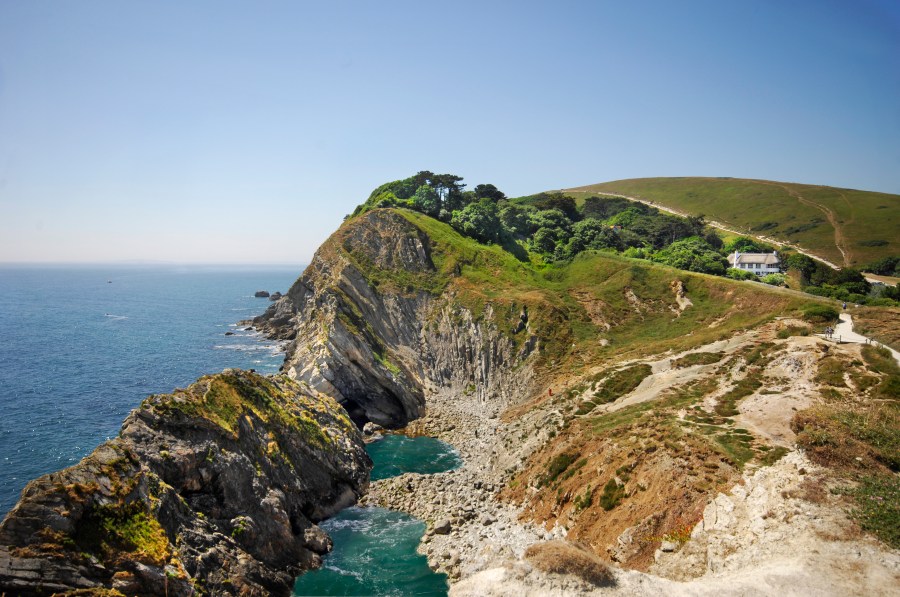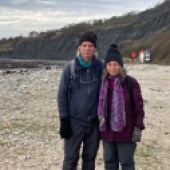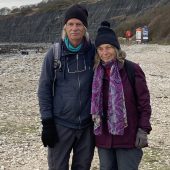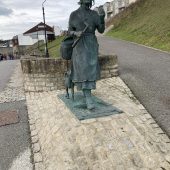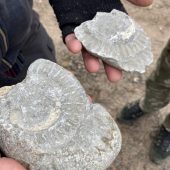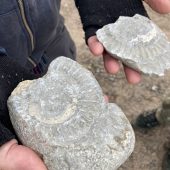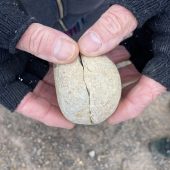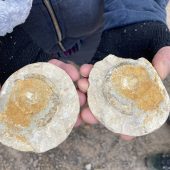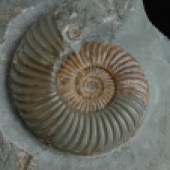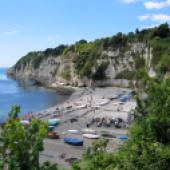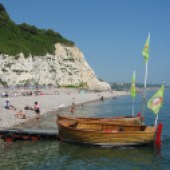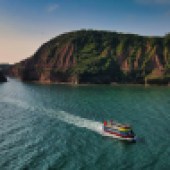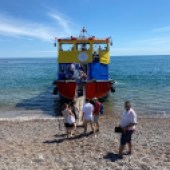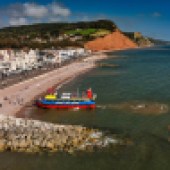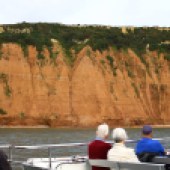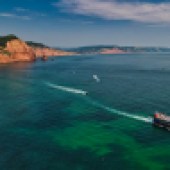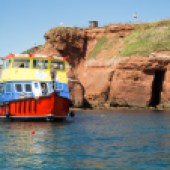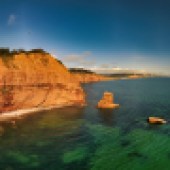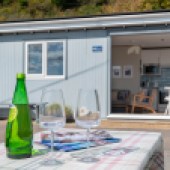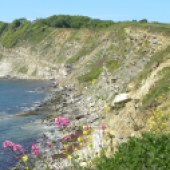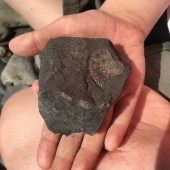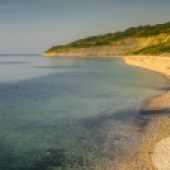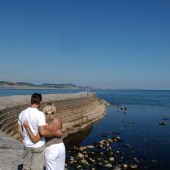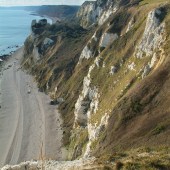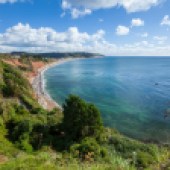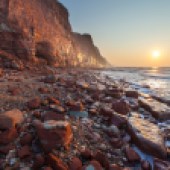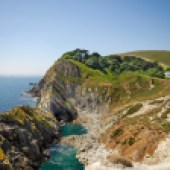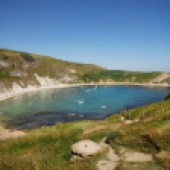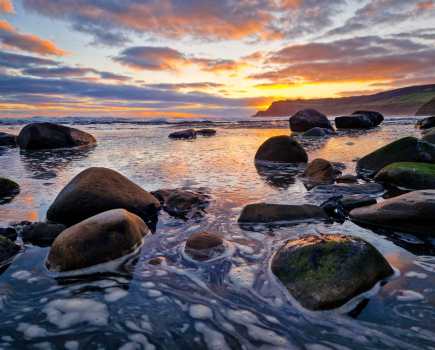There’s nothing quite like coming across your very own piece of the Earth’s history. CHRISSY HARRIS goes fossil hunting along the Jurassic Coast.
The anticipation is what drives you on. Could this next rock be the one? Am I about to discover a species unknown to science? “It’s pretty addictive,” says lifelong fossil enthusiast, Mike Green. “You start out and then the hours go by and you realise you’ve just been staring at the ground.”
Mike, a local Jurassic Coast ambassador, has kindly agreed to take me and my entourage (husband, two teenagers and a Labrador) out fossiling for the day along a stretch of this World Heritage site.
The Jurassic Coast spans 95 miles from Exmouth in East Devon to Studland Bay in Dorset and is the only place on earth where rocks from the Triassic Jurassic and Cretaceous periods can be seen in one place.
The scenery is mind-blowing – layers and layers of geology spanning as far as the eye can see. Except we’re not looking up.
“Here you go, there’s a really good one,” says Mike, pointing at an ammonite the size of a Frisbee on a rock, right in front of us. It’s beautiful, an ammonite just made for Instagram. Mike, who has been exploring this coastline for decades, has given us a teasingly straightforward start. We’ve come to Monmouth beach, on the Devon/Dorset border, at low tide and the fossils seem to find us.
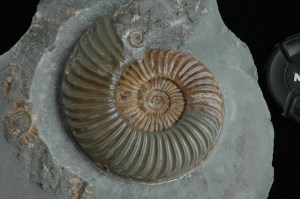
Everywhere you look there are traces of prehistoric life. There’s even the ‘ammonite pavement’, a huge slab of the fossilised shelled cephalopods that died out about 66 million years ago.
“You know that game you play on the pavement where you try to avoid stepping on the lines?” says Mike. “Well, see if you can dodge the ammonites – I bet you can’t.”
The kids are silently snapping away, capturing this moment on their phones – a sure sign that this is impressive stuff.
But now we know what we’re looking for, the challenge is on to find an ammonite no one in the world has even seen before.
“That’s the thing I enjoy about it and what I tell my grandkids, says Mike, who says fossil hunting is simply a much-loved hobby of his. “If you crack open that rock and find a fossil, you’re the first person ever to have seen it. That feeling never goes away.”
The fossil hunting code dictates that you can’t remove anything that’s fixed, so no digging into the cliffs or permanent bedrock and take only small, loose specimens. Leave the big, spectacular ones for everyone to enjoy.
“What you’re looking for is a wiggly line on the edge here,” says Mike, picking up a grapefruit-sized rock. “If you’re lucky, that line could be the edge of an ammonite. We can crack it open and have a look.”
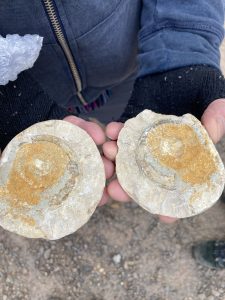
Mike has brought along his pack, which includes a geological hammer (and a picnic, also essential).
“Found one!” I call out, certain that this rock contains proof of prehistoric life.
“Hmmm, I think if we open that, you’re going to be disappointed,” says Mike, before sensing my disappointment. “But…we’ll give it go, if you like.”
He’s right, of course. Having an eye for this takes years of practice and we’ve been out for an hour and 20 minutes.
We are undeterred, however, and Mike suggests we head back to the cars and drive the short distance to Charmouth Beach, famous for its easy pickings.
The beach is mainly shingle and a great place to find small ammonite and belemnite fossils, as well as Iron Pyrite, also known as ‘fool’s gold’ because of its shiny colour.
We arrive to the sound of geological hammers chinking in the distance as professional hunters and a few dads get to work on bringing home the glory.
We each adopt our own fossil finding tactics. I mirror the behaviour of a woman who looks as though she knows what she’s doing by sitting down and carefully surveying each and every rock and pebble within a hand’s grasp.
My daughter Alice is in full smashing mode before gently trying to prize open the softer shale. Mike and his wife Carol have gone long, determined to find us an ancient souvenir along the other half of the beach.
“Get your eyes right and you’ll soon spot them,” Mike says to me as he passes by. “Try not to see what you want to see – look at what’s actually there.”
“Found one!”, says Alice, who has unveiled her very own ammonite in the mudstone. Clearly, her focus and precision (and smashing) has paid off and she gently places her find in her brother’s rucksack, already weighed down by some sizable stones.
By now, the tide is on the turn and we’re getting cold. We decide to head for the shelter of the Charmouth Heritage Coast Centre, a fabulous beach-side Jurassic haven where you can see an incredible array of finds, including Attenborough’s Sea Dragon.
The ichthyosaur, which has appeared in a BBC documentary, was discovered by local collector Chris Moore on Monmouth beach in 2016.
We stare at this beautiful fossil, found near where we just were. Imagine that.
“It’s extraordinary when you think about it, isn’t it?”, says Mike, agreeing there is such a thing as fossil envy. “We’ve just been walking along with millions of years of history right under our feet.”
And that’s the take home message, really. Just being here on this incredible, globally recognised coastline is enough to blow your mind. Finding a tiny piece of our planet’s past is just a bonus. jurassiccoast.org
WHERE TO LOOK
DEVON
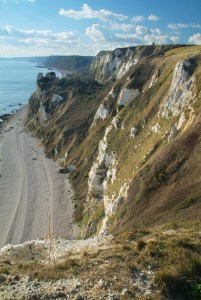
A lot of the geology here is from the Triassic era and fossils are rare but interesting finds are plentiful.
East from Branscombe towards Beer Head is Hooken Beach, where you can find loads of bivalve shells in the Early Cretaceous in the huge boulders that have fallen from the cliffs above.
And look out for bits of tubeworm layer. At first glance it looks like a flat large pebble covered in small ammonites. This is a particular layer from the Early Cretaceous and they can be found on the beaches from Little combe Shoot, Branscombe (the local pronounciation is Liddie-cum-shute) all the way to Culverhole Point, east of the River Axe.
Seaton Hole – On the beach between Seaton Hole and Beer you can find bivalves and ammonites in the rocks that have fallen from the cliffs above.
Search the pebble beaches along the East Devon Coast for fossil sea urchins in flint pebbles and the occasional bivalve (2 shells). You can also look for a “Budleigh Bun” – a pebble from Budleigh beach, washed eastward up the channel by a process called longshore drift.
They tend to be round, flat and purple coloured. They make great skimmers.
Make a stay of it with our favourite Devon hotels
DORSET
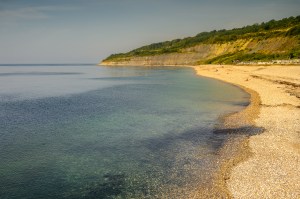
Walk in the steps of famous scientists in the birthplace of palaeontology. Lyme Regis is a great starting point, with Monmouth Beach being the best spot to see ammonites, belemnites and plant fossils.
And don’t forget to lookout for trace fossils, geological records of biological activity. They are fossils, but not of the living thing themselves.
Look for light grey marks on rocks, which could be fossilised burrows created by crustaceans. They can be seen in the big grey limestone slabs.
Charmouth Beach is farther along the coast from Lyme and also famous for its finds. Ammonites, belemnites (he internal hard parts of a squid-like animal), brittle stars, crinoids (animals related to starfish and sea urchins), they’re all here, as well as some rarer discoveries, such as Lower Jurassic fish – and the occasional Ichthyosaurs.
Victorian fossil hunting pioneer Mary Anning discovered the first ichthyosaur skeleton on the beach between Charmouth and Lyme Regis when she was just 12 years old.
Fossilised wood is also preserved in the grey limestone rocks, which protects the soft wood from decaying.
Chesil Beach is an 18-mile long shingle barrier beach stretching from West Bay to Portland and is one of Dorset’s most iconic landmarks. See how the pebbles change gradually, from potato-sized near Portland to pea-sized by West Bay.
Lulworth Cove is home to a dramatic ‘fossil forest’, the petrified remains of a cypress forest growing in a swamp on the edge of a warm lagoon in the Jurassic period. The forest is within the Lulworth Firing Range and can be visited only at certain times (most weekends and school holidays).
Durlston Bay is one of the most important Early Cretaceous fossil sites. Good finds are reliant on recent cliff falls. It’s worth noting that this is not a family destination. Aside from the heightened risk of cliff falls, the type and volume of fossils is more suited to experienced fossil hunters.
Make a stay of it with our favourite Dorset hotels
WHERE TO VISIT
Lyme Regis Museum overlooks Lyme Bay and the Jurassic Coast and is full of the rich historical and cultural history of the town.
Discover 200 million years of history, including the remarkable discoveries of the pioneering 19th century fossil hunter Mary Anning.
You can book a guided fossil walk here, too. See lymeregismuseum.co.uk
Speaking of Mary Anning, make sure you pay a visit to her statue, situated at the junction between Long Entry and Gun Cliff Walk in Lyme Regis.
Local schoolgirl Evie Swire and her mum Anya Pearson started the campaign to install a statue in Mary’s hometown back 2018. Evie, who regularly goes fossil hunting, couldn’t understand why there wasn’t a permanent memorial to Mary Anning. The statue was unveiled on 21 May last year by Professor Alice Roberts.
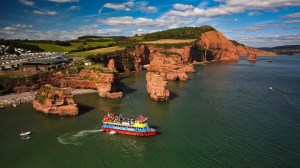
Climb aboard a Stuart Line cruise to see the Jurassic Coast in all its glory. The firm’s Jurassic Coast Cruises run from Exmouth from April to October. See stuartlinecruises.co.uk
See Attenborough ‘s Sea Dragon and other fascinating finds at the free-to-enter Charmouth Heritage Coast Centre. The team here organises guided fossil hunting walks, rock pooling session and beach cleans throughout the year. See charmouth.org
WHERE TO STAY
Lulworth Cove House, Dorset

This (very) large thatched cottage has stunning sea views and can sleep up to 20 guests, making it an ideal family getaway base. Lulworth Cove is a few minutes’ walk away.
There’s an indoor heated swimming pool, cinema room and games room.
A four-night self-catering stay costs from £11,480 with The Wow House Company.
Lyme Cordial, Lyme Regis, Dorset

A modern beach chalet with fabulous sea views, overlooking Monmouth beach and the famous Cobb of Lyme Regis.
Seven nights from £697 with Toad Hall Cottages
The Old Post Office, Morcombelake, Dorset

This quintessential country cottage is just a short drive from the sea.
Seven nights from £860 with Toad Hall Cottages
Higher Wiscombe, Devon

These four cottages sit in 52 acres of rolling countryside. There’s an outdoor heated pool in the summer. Hank’s Annex is named after Hank Marvin, the guitarist in The Shadows who lived at Higher Wiscombe.
The cottages are close to the beaches at Beer, Sidmouth and Branscombe.
Prices start from £1,150 for a week. Available through Premier Cottages.
After more inspiration? Take a look at our favourite dog-friendly Dorset hotels

